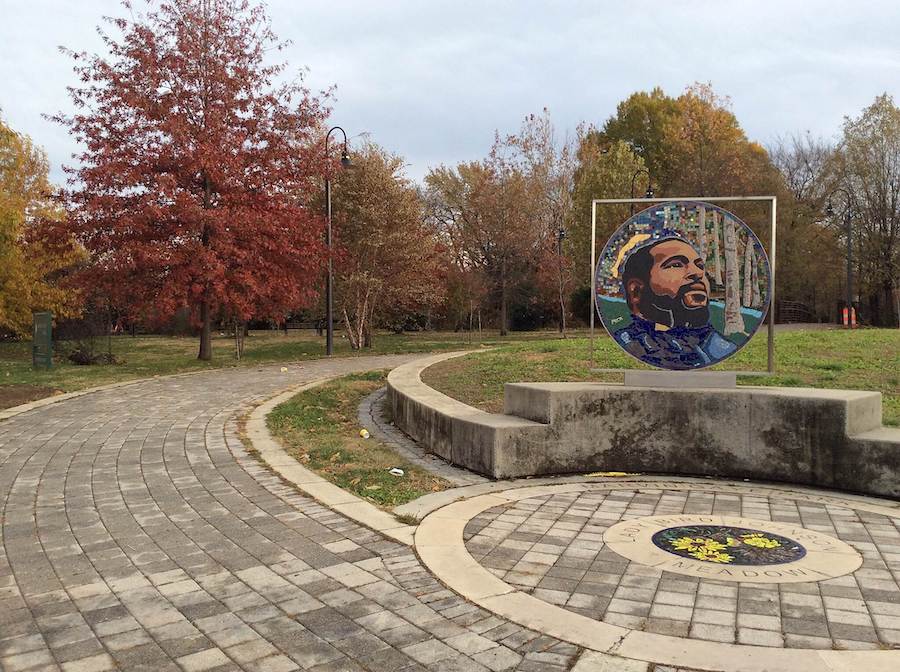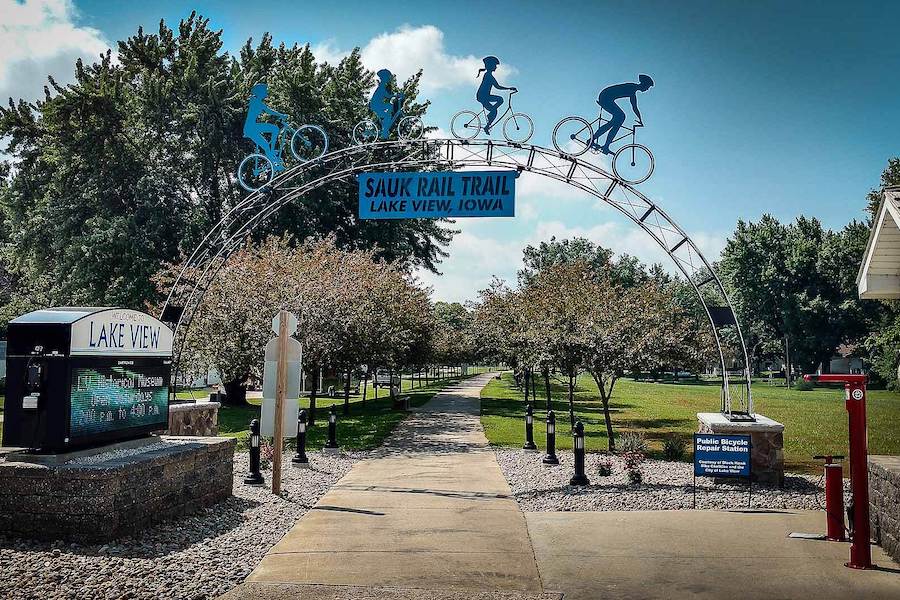Public Art
Delaware & Lehigh Trail | Photo by Thom Carroll
Public art can help elevate a rail-trail from practical infrastructure to a space cherished by the community. Art establishes the trail as a community asset and encourages public engagement and stewardship.
Art on a rail-trail can serve a variety of purposes. It can illustrate both the identity of the trail itself and the identity of the communities through which it winds. It can stimulate the mind and the senses, allow for rest or contemplation or encourage participation. Public art can cultivate vision and inspire change in the surrounding community.
Trail Identity
Trail identity can be established with a variety of artistic and functional pieces. Continuity and repetition in benches, drinking fountains and signage serve to “brand” the trail and provide a rhythm to the journey. Artistic ramps and railings, sculptures or winding work on the pathway mimic and reveal the flowing movement of the trail. Transitions like street crossings, turns or landscape changes can be illustrated with trail markers.
Community Identity
Rail corridors themselves can say a lot about the community’s identity, as the identity of an area often stems from its industrial history. Historical art can take the form of murals or sculptures, or make use of old railroad vestiges like machinery, ties or signage. Sculptor Jeff Sanders secured more than 100 painted cast bronze oranges for the Ventura River Trail in his sculpture “Orange Trace.” The oranges were made to look as if they had just spilled from the train that historically shipped produce in the area.
In Kansas City, the art along the Riverfront Heritage Trail speaks to the history and culture of the city, including its Native American, Latin American and Black heritage, as well as the legacy of the railroad and of Lewis and Clark’s expedition.
Sensory Engagement
Most art is visually or mentally stimulating, but some art is intended to animate other senses as well. The Fairfield Heritage Trail in Lancaster, Ohio, includes a sensory trail with herb pots, bird feeders, a tactile bark display and outdoor musical instruments. Changing seasons on a rail-trail make it a great backdrop for the changeable sensory elements found in a garden. The Alchemical Garden on Newburyport’s Clipper City Rail Trail includes edible plants, fruits and berries, as well as two couches made from living grass, encouraging participants to pause and rest in their surroundings.
Participatory Art and Events
When channeled appropriately, graffiti art can be beautiful and relevant to a neighborhood’s personality. Programs in Washington, D.C., and Detroit have simultaneously engaged local youth, discouraged vandalism and beautified the corridor by commissioning local graffiti artists to work in spaces set aside for their art.
Rail-trails are also great venues for artistic events. These gatherings help form partnerships among art, conservation and community groups, and they introduce new visitors to the rail-trail. Artistic events can also cultivate a common vision and inspire change. Citizens of Memphis, Tenn., turned badly degraded Broad Avenue, which connects to a local rail-trail, into a temporary complete street for a weekend. The event included temporary crosswalks and bike lanes, as well as businesses and restaurants setting up shop in abandoned buildings. The project was attended by an estimated 13,000 people, which contributed to the recent revitalization of the area and brought new users to the adjacent rail-trail.
Integrating Public Art into a Trail

This section will discuss factors to keep in mind when embarking on a trail art project. The content in this section is based on and discussed at length in the public art webinar embedded in this page. Another great resource is this public art tip sheet created by the Arcadiana Arts Council, which lists items to consider for a successful public art project.
Planning
For some trail developers, art is an afterthought, a way to enhance or program a trail that has already been designed and built. There are others for whom public art is part of the trail vision right from the start. Planners behind the Charlotte Rail Trail created a detailed Public Art Master Plan to guide the selection and installation of public art.
While planners on the Clipper City Rail Trail were already considering art in the early stages of the trail design, there was no master document to guide the vision. They preferred to start small and build up the art program incrementally and organically, starting with rotating temporary exhibitions and building up to a curated collection of permanent installations.
Temporary exhibitions are a way to test the public’s reaction to artwork on the trail; to have a tangible impact even with a short time frame and limited budget; and to help the trail manager to begin to build relationships and a network of artists. Temporary art may displayed for days, months or longer and costs of materials and of labor will usually be lower than those for permanent works.
Selection

How do you go about choosing the art for your trail? It depends. Each community makes the decisions that best fit their needs and the resources at their disposal.
Curation
Decide whether the art will be curated by a committee, an individual or a combination of both. Whichever route you choose, it’s always advantageous to tap into the network and knowledge of local arts groups if they are available to you. On the Clipper City Rail Trail, the project manager curates the art, with the final approval of the Mayor. Easton, Pennsylvania is a town with a strong artists’ legacy. Although the Karl Stirner Arts Trail collection is curated by an individual, the board of the trail consists of art experts together with municipal staff.
Artists
Many projects will engage local artists because of their availability, local knowledge, lower costs for travel and installation, and to help promote the local arts scene. Widening the search to a regional or national scale however, allows you to draw on a wider pool of talent. The Clipper City Rail Trail managers engaged mostly Massachusetts artists, but also included art from artists based elsewhere in New England.
Artists may be chosen via direct selection, limited invitations, an open call Request for Qualifications. Where project time and budget are limited, direct selection might be the best option. Where the funding allows, you might elect to go through an RFQ process, short list and perform interviews to choose artists. You can also engage the public in the process, like having them vote on their preferred design proposal from a shortlist.
Art typologies
The types of public art found on trails are easily as varied as the people that make them. Artwork typologies include:
- Sculptures
- Murals
- Trail surface painting
- Gardens
- Lighting
- Gates and fences
- Interactive art (where people are encouraged to interact with the art).
The media used to create the art also varies widely, from wood, stone, fiberglass, plastic, bronze, copper. When thinking about what media to include, remember that the art is displayed outdoors – exposed to the elements and to people. This also affects how much time and money is spent on maintenance. Masonry and concrete are especially durable but are expensive to install and require highly skilled fabricators. Metalwork is also resilient but may require waxing or exterior grade paint that will need to be reapplied periodically. Temporary installations may be constructed of less resilient materials.
Resources
‣ Fact sheet – Urban Pathways to Healthy Communities: Gardens
TrailNation Collaborative
TrailNation™ Collaborative is a nationwide peer learning community from Rails-to-Trails Conservancy that brings together advocates, leaders and professionals from across disciplines to establish and accelerate trail networks across America. The collaborative provides proven tools, methods and resources, combined with RTC’s expertise and network of partners across the country, to accelerate the development of connected trail systems. When trails are connected across regions and states, trail networks have a proven transformative impact—they are essential infrastructure that creates thriving, healthier communities.